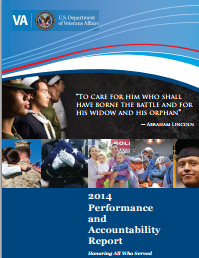- Home
- Agencies
- Department of Agriculture
- Department of Housing and Urban Development
- General Services Administration
- Department of Commerce
- Department of the Interior
- National Aeronautics and Space Administration
- Department of Defense
- Department of Justice
- National Science Foundation
- Department of Education
- Department of Labor
- Office of Personnel Management
- Department of Energy
- Department of State
- Small Business Administration
- Environmental Protection Agency
- Department of Transportation
- Social Security Administration
- Department of Health and Human Services
- Department of the Treasury
- U.S. Agency for International Development
- Department of Homeland Security
- Department of Veterans Affairs
- Goals
- Initiatives
- Programs
Primary tabs
Strategic Objective
Enhance Productivity and Improve the Efficiency of the Provision of Veteran Benefits and Services
Strategic Objective
Overview
Summary:
VA has a fundamental responsibility to be an effective steward of taxpayer dollars. VA must continue to eliminate wasteful spending and ensure that the proper controls, practices, and safeguards are in place to prevent misspending of tax dollars.
Strategies:
VA will continue to be good a steward of its resources by closely monitoring agency travel to mission essential needs. We will continue working to decrease improper payments, recapture misallocated funds, and dispose of unnecessary real estate.
VA will improve the models and systems used to forecast and capture cost. We will adopt the direct tracking of people, equipment, and consumables. We will implement a modernized financial management system.
VA will continue to mature its capability based planning, programming, budgeting, and execution (PPBE) process to tie strategy to budget and budget to performance.
VA will continue to review its internal buying patterns and identify opportunities for strategic sourcing to achieve significant savings for recurring requirements.
VA will develop a strategic capital equipment planning model and a plan to improve medical equipment life cycle.
Read Less...Progress Update
Final Assessment: VA, in consultation with the Office of Management and Budget, highlighted this objective as a focus area for improvement.
Achievements: In FY 2015, VA implemented two new Federal Strategic Sourcing Initiative (FSSI) solutions and two follow-on FSSI solutions: DDS3 (small package delivery), OS3 (office supplies), JanSan (janitorial & sanitation products), and MRO (maintenance, repair, and operations support). Collectively, VA spent $120 million against various FSSI solutions, generating $26 million in cost avoidance. The FSSI is a government-wide program that helps agencies partner together and leverage its buying power as a single enterprise.[1] Also, in February 2015, VA’s pharmaceutical, medical equipment, and IT software spend categories received “Tier 1” ratings using the Office of Management and Budget’s new Spend Under Management Maturity Model. Tier 1 is considered “excellence” by the Office of Management and Budget. Collectively, these three categories of managed spend account for approximately $8.5 billion (46 percent) of VA’s Federal Procurement Data System reported spending.
VHA and VA’s Office of Acquisitions, Logistics, and Construction’s Strategic Acquisition Center are partnering to implement medical-surgical strategic sourcing solutions which will better leverage VHA’s buying power in FY 2016 and beyond. VA is innovating to provide health care supplies while balancing strategic sourcing goals and small business program requirements.
Furthermore, the VA Requirements Board (VARB) reviewed the Department’s gaps across the enterprise on April 14 - 15, and 17, 2015. The results of the VARB were briefed to the Deputy Secretary on April 30, 2015. The Deputy Secretary tasked each Administration and Staff Office to identify key mission requirements, Veteran-centric standards, and the resources needed to manage their delivery by 2017. Also, there was successful resolution of the space needs addressed in VACAA.
Challenges: A challenge in strategic sourcing is that the VHA commodity management infrastructure is evolving too slowly to see rapid, significant strategic sourcing benefits in terms of reduced cost, process efficiencies, and improved customer satisfaction. Additionally, VA is utilizing an independent third-party organization’s report to assess and strengthen VA’s entire construction program.[2]
Also, some challenges in programming are a lack of a Programming Future Years Veterans Plan database, poor cross-functional integration, and a lack of identified trade-offs to close capability gaps. There is also an unclear return on investment or Value for Investment. Additionally, Medical Care associated growth continues to dwarf other issues within VA.








